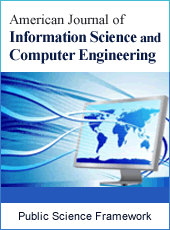American Journal of Information Science and Computer Engineering
Articles Information
American Journal of Information Science and Computer Engineering, Vol.3, No.1, Jan. 2017, Pub. Date: Jan. 21, 2017
Infrasonic Signals Clustering Based on Hilbert-Huang Transform and K-Means
Pages: 1-6 Views: 4336 Downloads: 1316
[01]
Xuanchicheng Luo, School of Infomation Engineering, China University of Geosciences, Beijing, China.
[02]
Shuqing Ming, School of Infomation Engineering, China University of Geosciences, Beijing, China.
[03]
Mei Li, School of Infomation Engineering, China University of Geosciences, Beijing, China.
[04]
Wei Tang, Comprehensive Nuclear-Test-Ban Treaty Beijing National Data Center, Beijing, China.
Because of the diversity of infrasound signals, it is difficult to classify different infrasound signals accurately. The different types of infrasound have different characteristics value in energy spectrum, therefore, this study obtained energy spectrum from which can extract the multi-dimensional feature vectors through the Hilbert-Huang transform (HHT) to distinguish different categories of infrasound signals. And then using the K-means algorithm to cluster multi-dimensional feature vectors, which has a good effect on solving the infrasound signal blind classification problem and increases the efficiency of signals clustering.
HHT, K-Means, Infrasound Signal, Cluster
[01]
LIU Jun-min, Tang Wei, WANG Xiao-ming, “Analysis of Mechanism to Produce Infrasound Signals and Its Characteristics”, Environmental Engineering, 2010, vol. 8, No. 4, pp. 92-96.
[02]
XU Wen-jie, GUAN Hong-yun, WU Xiao-lin, “Analysis of Debris Flow Infrasound Signal Based on Time-frequency Analysis Methods”, Computer and Modernization, 2013 (4), pp. 36-39.
[03]
LI Xin-xin, Research on Feature Extraction and Classification of Ship Noise and Whale Sound [D]. Harbin: Harbin Engineering University, 2012, 1-88.
[04]
ZHOU Xin, WU Ying, “Research on Signals Modulation Classification Based on SVM and RVM”, Journal on Communications, 2010, vol. 31, No. 8A, pp. 94-99.
[05]
PENG Ming-jin, LI Zhi, “Analysis and Feature Extraction of Laser Micro-Doppler Signatures Based on Hilbert – Huang Transforms”, Chinese Journal of Lasers, 2013, vol. 40, No. 8, pp. 0809004.1-6.
[06]
SUN Hui-bin, NIU Wei-long, WANG Jun-yang, “Tool wear feature extraction based on Hilbert-Huang transformation”, Journal of Vibration and Shock, 2015, vol. 34, No. 4, pp. 158-164.
[07]
CHI Hui-guang, The application of Hilbert–Huang Transform in Extraction of Mine Characteristics [D], Harbin: Harbin Engineering University, 2007, pp. 1-83.
[08]
N E Huang, M L Wu, S R Long, et al.. A Confidence Limit for the Empirical Mode Decomposition and Hilbert Spectral Analysis [J]. Proceeding of the Royal Society of London, Series A, 2003, 459 (2037), pp. 2317-2345
[09]
Huang N E, Shen Z, Long S R, et al. The empirical mode decomposition and the Hilbert spectrum for nonlinear and nonstationary time series analysis [J]. Proceedings of the Royal Society of London, Series A, 1998, 454 (1971): 903995.
[10]
SHEN Zhi-yuan, Research on the Theory and Application of Hilbert-Huang Transform [D], Harbin: Harbin Institute of Technology, 2010, pp. 1-54.
[11]
S Kizhner, TP Flatley, NE Huang, et al, On the Hilbert-Huang Transform Data Processing System development, Aerospace Conference, 2004 IEEE, vol 3.

ISSN Print: 2381-7488
ISSN Online: 2381-7496
Current Issue:
Vol. 7, Issue 3, September Submit a Manuscript Join Editorial Board Join Reviewer Team
ISSN Online: 2381-7496
Current Issue:
Vol. 7, Issue 3, September Submit a Manuscript Join Editorial Board Join Reviewer Team
| About This Journal |
| All Issues |
| Open Access |
| Indexing |
| Payment Information |
| Author Guidelines |
| Review Process |
| Publication Ethics |
| Editorial Board |
| Peer Reviewers |


